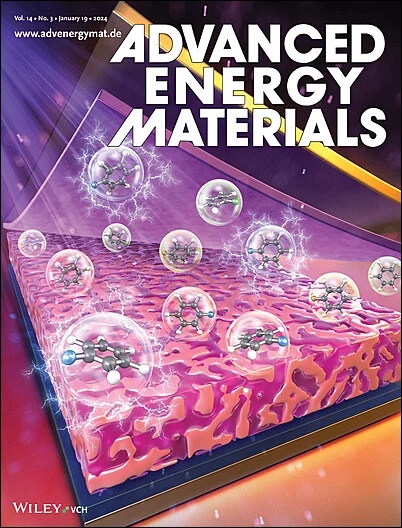基于梯度电荷修饰可持续木源纳米通道的自供电机械纳米流体发生器
IF 24.4
1区 材料科学
Q1 CHEMISTRY, PHYSICAL
引用次数: 0
摘要
便携式和可穿戴电子产品对自供电技术的需求不断增长,推动了能量收集系统的重大进步。然而,传统的基于摩擦电和压电效应的机械发电机受到放电持续时间短的限制,尽管实现了高输出电位。本文报道了一种具有梯度电荷修饰纳米通道的机械纳米流体发生器(MNG),设计用于机械能量收集。MNG具有高度排列的纳米通道和工程表面电荷,使峰值输出电压达到10.58±1.29 V,能量释放时间延长至675.80±112.08 s,比传统发电机的放电时间延长了几个数量级,通常在几毫秒到几微秒内放电。这种优异的性能归因于梯度表面电荷修饰的协同效应以及输运离子与表面电荷之间增强的相互作用。这种性能归因于表面电荷梯度的协同效应和离子-表面相互作用的增强,强调了MNG作为下一代自供电系统的潜力。本文章由计算机程序翻译,如有差异,请以英文原文为准。
Self‐Powered Mechanical Nanofluidic Generators Based on Gradient Charge‐Modified Sustainable Wood‐Derived Nanochannels
The growing demand for self‐powered technology in portable and wearable electronics has spurred significant advancements in energy harvesting systems. However, conventional mechanical generators based on triboelectric and piezoelectric effects are limited by short discharge durations, despite achieving high output potentials. Here, a mechanical nanofluidic generator (MNG) is reported with gradient charge‐modified nanochannels, designed for mechanical energy harvesting. The MNG features highly aligned nanochannels with engineered surface charges, enabling a peak output voltage of 10.58 ± 1.29 V and a prolonged energy release time of 675.80 ± 112.08 s, with orders of magnitude longer than traditional generators that normally discharge in milliseconds to microseconds. This superior performance is attributed to the synergistic effects of gradient surface charge modification and enhanced interactions between transport ions and surface charges. This performance is attributed to the synergistic effects of surface charge gradients and strengthened ion–surface interactions, underscoring the MNG's potential for next‐generation self‐powered systems.
求助全文
通过发布文献求助,成功后即可免费获取论文全文。
去求助
来源期刊

Advanced Energy Materials
CHEMISTRY, PHYSICAL-ENERGY & FUELS
CiteScore
41.90
自引率
4.00%
发文量
889
审稿时长
1.4 months
期刊介绍:
Established in 2011, Advanced Energy Materials is an international, interdisciplinary, English-language journal that focuses on materials used in energy harvesting, conversion, and storage. It is regarded as a top-quality journal alongside Advanced Materials, Advanced Functional Materials, and Small.
With a 2022 Impact Factor of 27.8, Advanced Energy Materials is considered a prime source for the best energy-related research. The journal covers a wide range of topics in energy-related research, including organic and inorganic photovoltaics, batteries and supercapacitors, fuel cells, hydrogen generation and storage, thermoelectrics, water splitting and photocatalysis, solar fuels and thermosolar power, magnetocalorics, and piezoelectronics.
The readership of Advanced Energy Materials includes materials scientists, chemists, physicists, and engineers in both academia and industry. The journal is indexed in various databases and collections, such as Advanced Technologies & Aerospace Database, FIZ Karlsruhe, INSPEC (IET), Science Citation Index Expanded, Technology Collection, and Web of Science, among others.
 求助内容:
求助内容: 应助结果提醒方式:
应助结果提醒方式:


